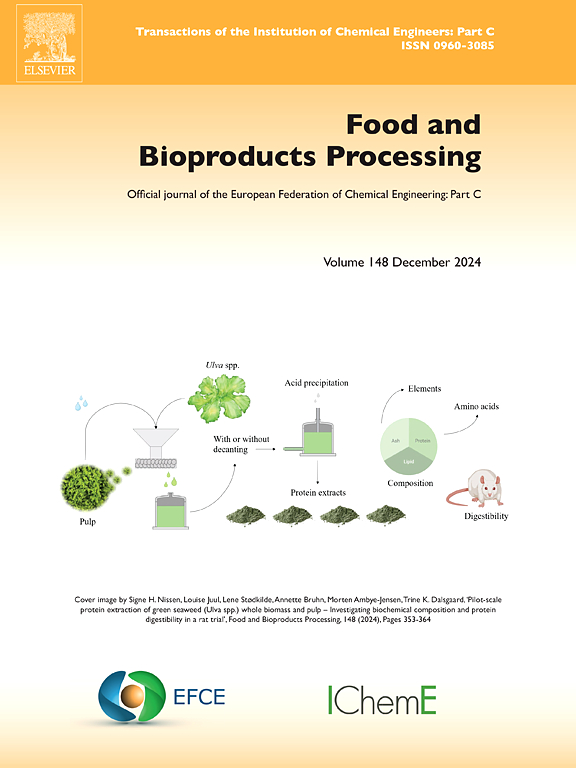提高植物营养素在强化共晶凝胶中的稳定性:利用天然深共晶溶剂(NADES)调节榴莲籽胶和油棕叶提取物在食品涂层中的应用
IF 3.4
2区 农林科学
Q2 BIOTECHNOLOGY & APPLIED MICROBIOLOGY
引用次数: 0
摘要
榴莲籽胶(DSG)的产率和功能特性在很大程度上取决于提取工艺。干籽法在高温碱性条件下水提DSG得率最高(31.06 %),剪切减薄性能、胶凝性能和吸附性能最理想,可用于食品包衣中的共聚苯胺配方。采用氯化胆碱-果糖(1:2)天然深共晶溶剂(NADES)萃取油棕叶中酚类化合物,其萃取效率高、稳定性好。最佳提取温度为40℃,提取时间为20 min,料液比为0.02 g/mL,总酚含量最高为28.22 mg/g OPL。高粘度共聚物保护营养物质免受氧化,并在40天的储存中表现出优异的稳定能力。NADES和DSG对没食子酸的降解率分别比共tectol高近2倍和10倍。本研究揭示了含油棕叶提取物(OPLE)的强化共tectol作为一种新型食品保鲜涂层材料的潜力。DSG和OPLE的提取工艺以及NADES和共聚酯的配方都是可调整的,以达到所需的性能和应用。本文章由计算机程序翻译,如有差异,请以英文原文为准。
Improved stability of phytonutrients in fortified eutectogel: Tuning durian seed gum and oil palm leaf extract using natural deep eutectic solvent (NADES) for food coating application
The yield and functional properties of durian seed gum (DSG) are highly dependent on the extraction process. Aqueous-extracted DSG from dry seed at high temperature and alkaline condition (dry seed method) showed the highest yield (31.06 %) and the most desired shear-thinning behaviours, gelling and sorption properties for eutectogel formulation in food coating application. Choline chloride-fructose (1:2) natural deep eutectic solvent (NADES) was used to extract the phenolic compounds from oil palm leaves (OPL) due to its higher efficiency and stability in eutectogel formulation. The optimal extraction temperature, time and solid-to-liquid ratio were found at 40 °C, 20 min and 0.02 g/mL, respectively, to achieve maximum total phenolic content (TPC) yield of 28.22 mg/g OPL. The high viscosity eutectogel protected nutrients from oxidation and demonstrated excellent stabilization ability over 40 days of storage. The degradation rate of gallic acid in NADES and DSG were almost 2-fold and 10-fold higher than eutectogel, respectively. This study shed light on the potential of fortified eutectogel containing oil palm leaf extract (OPLE) as a novel coating material in food preservation. The extraction processes of DSG and OPLE, as well as the formulation of NADES and eutectogel are tunable for desired properties and application.
求助全文
通过发布文献求助,成功后即可免费获取论文全文。
去求助
来源期刊

Food and Bioproducts Processing
工程技术-工程:化工
CiteScore
9.70
自引率
4.30%
发文量
115
审稿时长
24 days
期刊介绍:
Official Journal of the European Federation of Chemical Engineering:
Part C
FBP aims to be the principal international journal for publication of high quality, original papers in the branches of engineering and science dedicated to the safe processing of biological products. It is the only journal to exploit the synergy between biotechnology, bioprocessing and food engineering.
Papers showing how research results can be used in engineering design, and accounts of experimental or theoretical research work bringing new perspectives to established principles, highlighting unsolved problems or indicating directions for future research, are particularly welcome. Contributions that deal with new developments in equipment or processes and that can be given quantitative expression are encouraged. The journal is especially interested in papers that extend the boundaries of food and bioproducts processing.
The journal has a strong emphasis on the interface between engineering and food or bioproducts. Papers that are not likely to be published are those:
• Primarily concerned with food formulation
• That use experimental design techniques to obtain response surfaces but gain little insight from them
• That are empirical and ignore established mechanistic models, e.g., empirical drying curves
• That are primarily concerned about sensory evaluation and colour
• Concern the extraction, encapsulation and/or antioxidant activity of a specific biological material without providing insight that could be applied to a similar but different material,
• Containing only chemical analyses of biological materials.
 求助内容:
求助内容: 应助结果提醒方式:
应助结果提醒方式:


